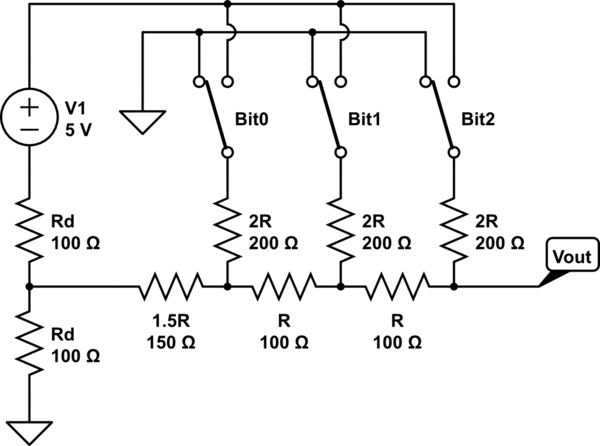I'm looking to make a DAC for my Arduino so that I can generate values spanning almost completely from 0V to the 5V supply. Because I won't have access to any +12V or -12V rails or anything, I'm afraid that I won't be able to incorporate any op-amps or other active components.
Fortunately, R-2R resistor network DAC's fit the bill almost perfectly...

simulate this circuit – Schematic created using CircuitLab
Fortunately, the thing I'm driving this with has high input-impedance, so this circuit works very well for my needs. However, I don't need the lower voltages in the range, so I was hoping to develop a resistor network which had an offset. So, for a network of n bits, instead of getting 2^n values within 0V-5V, maybe I could get 2^n values between, say, 1V-5V.
While googling around, I came across a priceless snippet on Wikipedia which read: "It is not necessary that each "rung" of the R-2R ladder use the same resistor values. It is only necessary that the 2R value matches the sum of the R value plus the Thévenin-equivalent resistance of the lower-significance rungs.". So, I figured that I might be able to add in a little voltage-divider to "lift" the ground that the main network is seeing:

Because the Thevenin resistance of the lower-left corner (the two 100-ohm resistors in the voltage divider plus the 150-ohm resistor) is still 200 ohms, I still get fairly linear voltages with increasing binary values.
However, this arrangement leaves two things to be desired. First, it requires that I know, beforehand, how much of a lift I'll want. It would be nice if I could have a potentiometer in there, somewhere, so that I could just dial in whatever lift I want.
Second, there's a limit to the amount of lift I can get. Even if I tweak the voltage divider to give me the full 5V feeding into the left side of the circuit, it looks like the most lift I can get is (5V/2^n).
Does anybody know of different ways of tweaking the circuit to solve either of these issues?


